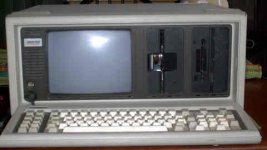fred3rd
Experienced Member
What did I find? It's definitely a Compaq portable, but which one. I think an origional portable from 1983. The fcc id # is cnt 75mcompaq and the model is COMPAQ, according to the data plate on it. The only badge on the unit is COMPAQ. It has the drive bays going top to bottom (vertical) as apposed to the Portable II I had with the drive bays running left to right (horizontal). The real puzzler is the fact that it has 1) full height 5 1/4 floppy drive, 1) half height 3 1/2 floppy drive, and 1) 1/2 height HDD. All information I've found on the original Portable only specs it with 2) 5 1/4 floppy drives.
Also what OS is it capable of, basic, dos 1.0 ?
I've attached a photo to help in identifying this gem.
Also what OS is it capable of, basic, dos 1.0 ?
I've attached a photo to help in identifying this gem.
Attachments
Last edited:



